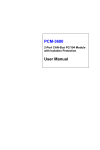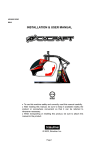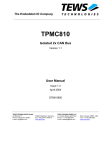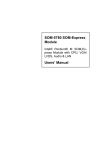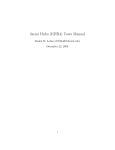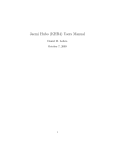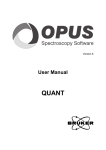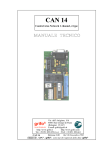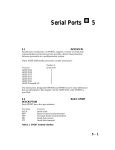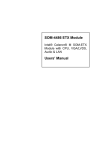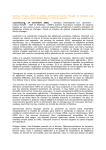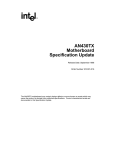Download PCM-3680 PC/104 Dual Port CAN Interface Module
Transcript
•
•
Takes a 4 KB address space, 40 base address
adjustable in steps from C800H up to EF00H
•
Optical isolation protection of 1000 VDC ensures
system reliability
•
Wide IRQ selection for each port includes:
IRQ 3, 4, 5, 6,7, 9, 10, 11, 12, 15
•
LED indicates Transmit/Receive status on each port
•
Direct memory mapping enables speedy access to
the CAN controllers
•
C library and examples included
Jumper & Switch Locations
Signal support: CAN-L, CAN-H
•
Memory address: From C800H to EF00H
•
IRQ: 3, 4, 5, 6, 7, 9, 10, 11, 12, 15
•
Isolation voltage: 1000 VDC
•
Power consumption: +5 V @ 400 mA typical,
950 mA max.
•
Connectors: Dual DB-9 male connectors
•
Operating temperature: 32 to 122° F (0 to 50° C)
•
PC/104 form factor: 3.6" x 3.8"
(90 mm x 96 mm)
•
Shipping weight: 0.9 lb (0.4 kg)
PCM-3680 User's Manual
PC/104 and the PC/104 logo are trademarks of the PC/104 Consortium
CH#1
CH#2
3
4
5
6
7
9
10
11
12
15
JP6
TR2
CAN transceiver: 82C250
•
CH#1
TR1
DIPSW
IRQ
JP5
A17
A16
A15
•
A14
CAN controller: 82C200
RX1 TX2 RX2
CH#1
TX1
A13
A12
Ports: 2
•
E S
16 MHz CAN controller frequency
On-board optical isolators protect your PC and
equipment against damage from ground loops,
increasing system reliability in harsh environments.
•
L
High speed transmission up to 1 Mbps
•
Optical Isolation Protection
Specifications
E
Operates 2 separate CAN networks at the same time
•
Direct Memory Mapping
The PCM-3680 is assigned with memory address,
which allows direct access to the CAN controller. This
is the simplest and fastest way of programming any
board in a PC because the board is regarded as
standard RAM.
EM B
Features
Control Area Network
The CAN (Control Area Network) is a serial bus
system especially suited for networking "intelligent"
I/O devices as well as sensors and actuators within a
machine or plant. Characterized by its multi-master
protocol, real-time capability, error correction, high
noise immunity, and the existence of many different
silicon components, the CAN serial bus system,
originally developed by Bosch for use in automobiles,
is increasingly being used in industrial automation.
M O DU
CH#2
The PCM-3680 is a special purpose communication
card that brings the Control Area Network to your PC.
With the built-in CAN controller, the PCM-3680
provides bus arbitration and error detection with
automatic transmission repeat function. This drastically
avoids data loss and ensures system reliability. The
on-board CAN controllers are located at different
positions in the memory. You can run both CAN
controllers at the same time, independently. The
PCM-3680 operates at baud rates up to 1 Mbps and
can be installed directly into the expansion slot of your
PC.
04
CH#2
IJumper Settingntroduction
P
1
C/
B1
A1
PCM-3680 PC/104 Dual Port CAN Interface Module
PCM-3680 PC/104
Dual Port CAN Interface Module
ED-PC
DD
B32
A32
C20
D20
C1
D1
PCM-3680 REV. A1
1
Part no. 2000368000 1st Edition Printed in Taiwan May 1996
Memory Base Address (SW1)
Initial Inspection
In addition to this user’s manual, your shipping box should
contain the following items:
• PCM-3680 Dual-port CAN Interface Card
• C Driver and DataMonitor Utility Diskette
WARNING!
Discharge your body’s static electric
charge by touching the back of the
grounded chassis of the system unit
(metal) before handling the board. You
should avoid contact with materials that
hold a static charge such as plastic,
vinyl, and styrofoam. The board should
be handled only by its edges to avoid
static damage to its integrated circuits.
Avoid touching the exposed circuit
connectors.
The memory base address for the PCM-3680, which
requires 4 KB of address space, is made up of the memory
segment and its associated offset. The address for the
memory segment is set through SW1, a six-position DIP
switch. You can choose any base address from C800 to
EF00. The following table shows the DIP switch settings
and the corresponding base addresses.
Memory address configuration (SW1)
Address/DIP switch
C800H
A12
on
A13
on
A14
on
A15 A16
off on
A17
on
C900H
off
on
on
off
on
on
CA00H
on
off
on
off
on
on
CB00H
off
off
on
off
on
on
CC00H
on
on
off
off
on
on
CD00H
off
on
off
off
on
on
CE00H
on
off
off
off
on
on
CF00H
off
off
off
off
on
on
D000H
on
on
on
on
off
on
D100H
off
on
on
on
off
on
D200H
on
off
on
on
off
on
D300H
off
off
on
on
off
on
D400H
on
on
off
on
off
on
D500H
off
on
off
on
off
on
D600H
on
off
off
on
off
on
D700H
off
off
off
on
off
on
Switch and jumper functions
D800H
on
on
on
off
off
on
IRQ Setup
D900H
off
on
on
off
off
on
Installation
Card Configuration
The PCM-3680 has two ports, each with one jumper. The
jumpers set the IRQ for the ports, which can be configured
separately. A DIP switch sets the memory base address for
each port. The following chart shows the function of the
jumper and the switch (see the previous page for jumper
and switch locations).
JP1
Port 1
DA00H
on
off
on
off
off
on
JP2
Port 2
DB00H
off
off
on
off
off
on
DC00H
on
on
off
off
off
on
DD00H
off
on
off
off
off
on
Memory base address
SW1
Port 1, Port 2
Default Settings
DE00H
on
off
off
off
off
on
DF00H
off
off
off
off
off
on
•
Port 1 is set for COM1 (IRQ=12, Memory address =
DA00:0000).
E000H
on
on
on
on
on
off
•
Port 2 is set for COM2 (IRQ=15, Memory address =
DA00:0200).
E100H
off
on
on
on
on
off
E200H
on
off
on
on
on
off
If you need to change these settings, see the following
sections. Otherwise, you can simply install the card. Note
that you will need to disable your CPU card's on-board
COM ports, if any, or set them to alternate addresses/IRQs.
E300H
off
off
on
on
on
off
E400H
on
on
off
on
on
off
E500H
off
on
off
on
on
off
E600H
on
off
off
on
on
off
Jumpers and Switches
E700H
off
off
off
on
on
off
Jumpers JP1 and JP2 set the interrupts for Port 1 and Port
2, respectively. You can choose any IRQ from 3 to 15,
except 8, 13 and 14. When you choose IRQs, make sure
they are not used for other cards in the system. The
following figures show the card's default settings.
E800H
on
on
on
off
on
off
E900H
off
on
on
off
on
off
EA00H
on
off
on
off
on
off
EB00H
off
off
on
off
on
off
JP1: Port 1 IRQ Default
EC00H
on
on
off
off
on
off
ED00H
off
on
off
off
on
off
EE00H
on
off
off
off
on
off
EF00H
off
off
off
off
on
off
IRQ Ch.1
3 ¡¡
4 ¡¡
5 ¡¡
6 ¡¡
7 ¡¡
9 ¡¡
10 ¡ ¡
11 ¡ ¡
12 ¡ ¡
15 ¡ ¡
2
JP2: Port 2 IRQ Default
IRQ Ch.2
3 ¡¡
4 ¡¡
5 ¡¡
6 ¡¡
7 ¡¡
9 ¡¡
10 ¡ ¡
11 ¡ ¡
12 ¡ ¡
15 ¡ ¡
PCM-3680 User's Manual
Memory Area
Function 2
Once the memory segment for the base address is
selected, the offset will be automatically assigned for Port
1, Port 2, and hardware reset. The following table shows the
base addresses of the CAN controllers.
Releases all settings of the CAN card.
Base address (hex)
CAN controller
base:0000h - base:00FFh
Basic- Port 1
base:0100h - base:01FFh
HW reset Basic - Port 1
base:0200h - base:02FFh
Basic- Port 2
base:0300h - base:03FFh
HW reset Basic - Port 2
base:0400h - base:0FFFh
Not used
å
Command
canExitHW()
å
Argument
None
å
Response
1=successful
0=fail
å Example
#include "can841.h"
main()
{
if (canExitHW()==0)
printf ("CAN RELEASE FAIL!\n");
}
Software Programming
Function 3
Resets CAN port and flushes the TX/RX buffers.
Quick Reference Table
The following table lists the available functions and their
corresponding syntax and descriptions.
Library functions
Function
1
Syntax (in C)
canInitHW()
Description
Sets IRQs
2
canExitHW()
Releases settings
3
canReset()
Resets CAN port
4
canConfig()
Controls CAN port settings
5
canNormalRun()
Sets mode
6
canSendMsg()
Sends message
7
canReceiveMsg()
Reads data
Complete Function Description
å
Command
int canReset (BYTE port);
å
Argument
BYTE port; port= port number (0 or 1)
å
Response
1=successful
0=fail
å Example
#include "can841.h"
main()
{
if (canReset (0)==0)
printf ("RESET PORT 1 FAIL!\n");
}
Function 4
Controls the setting of the CAN port's acceptance code,
acceptance mask, and bus timing register.
Function 1
å
Command
canConfig (BYTE port, CAN_STRUCT can);
Sets an IRQ number for Port1 and Port 2.
å
Argument
BYTE port, CAN_STRUCT can;
port= port number (0 or 1)
can= CAN struct pointer
å
Response
1=successful
0=fail
å
Command
canInitHW (UI segment, BYTE
IRQ1, BYTE IRQ2)
å
Argument
UI segment, BYTE IRQ1, BYTE IRQ2
segment=c000-df00 step 0x100
IRQ1=Port 1 IRQ number 0 (polling),
3, 4, 5, 6, 7, 8, 9, 10, 11, 12, 14, 15
IRQ2=Port 2 IRQ number 0 (polling),
, 4, 5, 6, 7, 8, 9, 10, 11, 12, 14, 15
0: polling
å
Response
å
Example
#include "can841.h"
main()
{
UI gSegment=0xDA00;
BYTE CAN1_IRQ, CAN2_IRQ;
CAN1_IRQ=12;
CAN2_IRQ=15;
if (canInitHW (gSegment, CAN1_IRQ, CAN2_IRQ)==0)
printf ("HARDWARE INITIALIZATION ERROR!\n");
}
1=successful
0=fail
PCM-3680 User's Manual
å Example
#include "can841.h"
main()
{
CAN_STRUCT can1, can2;
can1.acc_code=0;
can1.acc_mask=0xff;
can1.bt0=0;
can1.bt1=0x1c;
if (canConfig(0,can1)==0)
printf ("CAN PORT 1 CONFIGURE ERROR!\n");
}
3
Function 5
Example Program
Sets a CAN port to normal mode for normal operation.
å
Command
canNormalRun (BYTE port);
å
Argument
BYTE port;port= port number (0 or 1)
å
Response
1=successful
0=fail
å Example
#include "can841.h"
main()
{
if (canNormalRun(0)==0)
printf ("CAN Port 1 can't change to Normal Mode!\n");
}
Function 6
Tells the CAN port to send a message.
å
Command
canSendMsg (BYTE port,
MSG_STRUCT send_msg);
å
Argument
BYTE port, MSG_STRUCT send_msg;
port= port number (0 or 1) send_msg=
send buffer pointer
å
Response
1=successful
0=fail
å Example
#include "can841.h"
main()
{
MSG_STRUCT smsg1;
UI i;
smsg1.id=0x015;
smsg1.rtr=0;
smsg1.dlen=8;
for(i=0; i<smsg1.dlen; i++)
smsg1.data[i]=i;
if (canSendMsg(0,smsg1)==1)
printf ("TRANSMISSION SUCCESSFUL!\n");
}
Function 7
Read data from CAN port input buffer.
å
Command
int canReceiveMsg (BYTE port,
MSG_STRUCT *msg_ptr);
å
Argument
BYTE port, MSG_STRUCT *msg_ptr;
port= port number (0 or 1) *msg_ptr=
input buffer pointer
å
Response
1=message received
0=no message received
å Example
#include "can841.h"
main()
{
MSG_STRUCT rmsg2;
if (canReceiveMSG, *rmsg2)==1)
{
printf ("Port2 receive: ID=%3X RTR=%ld
Length=%ld", rmsg2.id, rmsg2.rtr, rmsg2.dlen);
for (i=0; i<rmsg2.dlen; i++)
cprintf (" %2X", rmsg2.data[i]);
}
}
4
The following example program, can841.lib, implements the
sending and receiving of messages over the CAN
controller. The program is written in C.
#include “can841.h” /*Library function declaration*/
/*---------------------------------------*/
/* CAN controller interrupt connection */
#define CAN1_IRQ 12 /* 0 means polling */
#define CAN2_IRQ 15 /* 0 means polling */
#define PORT1
0
#define PORT2
1
#define FAIL
0
#define SUCCESS 1
void main(void)
{
/* Declare the CAN card segment address. */
UI gSegment=0xDA00;
CAN_STRUCT can1, can2;
MSG_STRUCT smsg1, smsg2;
MSG_STRUCT rmsg1, rmsg2;
UI i;
if(canInitHW(gSegment,CAN1_IRQ,CAN2_IRQ)==FAIL)
{
clrscr();
cprintf("\n\n Hardware Initializa
tion Error");
return;
}
/* Reset CAN controller */
canReset(PORT1);
canReset(PORT2);
can1.acc_code=0;
/*
*/
can1.acc_mask=0xff;
/*
*/
can1.bt0=03;
/*baud rate 1Mbps*/
can1.bt1=0x1c;
if(canConfig(PORT1,can1)==FAIL)
{
clrscr();
cprintf("\n\n CAN Port %d Configuration
Error",1);
return;
}
memcpy(&can2, &can1, sizeof(CAN_STRUCT));
if(canConfig(PORT2,can2)==FAIL)
{
clrscr();
cprintf("\n\n CAN Port %d Configuration
Error", 2);
return;
}
canNormalRun(PORT1); /*Put CAN1 into normal mode.*/
canNormalRun(PORT2); /*Put CAN2 into normal mode.*/
clrscr();
smsg1.id = 0x015;
/* Set ID =8
*/
smsg1.rtr=1;
/* Data lengths =8 */
smsg1.dlen=8;
for(i=0; i<smsg1.dlen; i++)
smsg1.data[i] =i;
while(1)
{
canSendMsg(PORT1, smsg1); /*Send to CAN1*/
if(canReceiveMsg(PORT2, &rmsg2)==1)
{
cprintf("PORT2 receive:ID=%3X
RTR=%1d Length=%1d",
rmsg2.id,rmsg2.rtr, rmsg2.dlen);
PCM-3680 User's Manual
for(i=0; i< rmsg2.dlen; i++)
cprintf(" %2X",rmsg2.data[i]);
printf("\n");
The port configuration window is shown below.
}
if (kbhit())
{
getch();
break;
}
}
/* Reset CAN controller. */
canReset(PORT1);
canReset(PORT2);
canExitHW();
clrscr();
The parameters below need to be configured for each CAN
controller:
}
Address segment: The base address (address segment)
of the PCM-3680 is normally adjusted during the installation
process. The selection of the address segment needs to be
the same as that of the hardware configuration.
DataMonitor Utility
Software Overview
Port: Select the port you want to configure.
The PCM-3680 comes with a utility disk with the following
software capabilities:
• CAN controller configuration
• CAN transmission monitoring
Baud rate: The baud rate must be coordinated with the
CAN network. Choose the appropriate one from the list of
baud rates.
Acceptance code: Specifies the value of the 8 most
significant bits of the identifier (ID10 ... ID 3)
• Terminal emulation
Acceptance mask: Specifies the bit positions which are
"relevant" for acceptance filtering.
Main Menu
Run DataMonitor at the DOS prompt. DataMonitor's main
menu screen will appear as shown below:
A
Note: The acceptance code and acceptance mask are
configured through eight digits (1 digit per bit) using 0 or 1.
Value
C
B
Definition
0
This bit position will accept only a "relevant"
message.
1
This bit position will not screen messages.
C
C
C
D
The main screen consists of:
A. Menu bar: Lists the available functions. From the main
menu you can select Configuration, Monitoring, and
Terminal.
B. Monitor screen: Shows monitored data, including
message index, CAN device ID, data length, and data.
C. Status fields: Display the status of the two ports and
the status register of the CAN controllers.
D. On-line help/message bar: Shows various key
commands and states the function of the currently
highlighted item.
Configuration
Example:
Acc Code = 11111111
Acc Mask =11111111
The shown acceptance filter will accept every received
message.
Interrupt: Sets the interrupt forCeach port. Be sure that
this setting matches the IRQ already selected for the PCM3860, which accepts values between IRQ3 to IRQ15,
except 8 and 13.
Running mode: During the normal configuration and
communication process, select Normal Mode. When the
system fails, you can hit <Enter> to reset the CAN
controller. Hit <Enter> again to return
to Normal Mode to
C
further execute your configuration.
Monitor
Select the port to be monitored from the <Monitor> pulldown menu. Press F3 to start and stop the monitoring
process.
Before you transmit a CAN object, you must configure the
CAN controller by selecting the <Config> menu with the
cursor keys and pressing <Enter>. The Configuration
function determines the ports to be used and their
communication parameters.
PCM-3680 User's Manual
5
Monitor Screen
The monitored data for a selected port appears in the
monitor screen (see area B in the diagram under Main
Menu section.)
If the CAN controller is configured correctly and the
transmission has been successfully completed, every CAN
object will be shown in order of appearance.
Status Fields
Status fields at the right of the screen display the status of
the two ports:
Transmitting Data
To transmit data, the PCM-3680 must be connected to a
CAN network with at least one node and the configuration
for the card must be complete.
First, select <Terminal> to edit the data. Enter the port, the
object ID and the data bytes as hexadecimal value. Press
<Enter> to begin data transmission. If the CAN controller is
configured correctly and the transmission has been
successfully completed, every CAN object will be shown in
order of appearance at the left side of the screen.
Testing Data Transmission
The status fields show information including the Mode
(Normal or Reset), Acceptance Code, Acceptance Mask,
BTR0, BTR1, Output Control Register, and Status Register.
The normal value of the Status Register is:
00001100
Receive Buffer Status
Data Overrun Status
Transmit Buffer Access
Transmission Complete Status
Receive Status
Transmit Status
Error Status
Bus Status
To test CAN transmission without actually sending, connect
Port 1 to Port 2 on the PCM-3680. Select <Terminal> and
enter port 1 as transmitting port. Port 2 will therefore be
designated as receiving port.
Note: To send Data Frame (Transmit), enter "0" for RTR. If
you want to send Remote Frame (Request), enter "1" for
RTR.
The registers can only be read if the CAN controller is in
Normal mode. If the CAN controller operates correctly and
the transmission has been completed successfully, the
status register will show as the normal value: 00001100. If
the Error Status and/or the Bus Status is 1, you have
selected the wrong baud rate or the CAN cable is damaged.
Also check the correct bus terminator.
Terminal
This function provides a direct way to:
1. Send data over the CAN network.
2. Test CAN transmission.
Select <Terminal> from the menu bar for the following
screen:
6
PCM-3680 User's Manual
Wiring
Register Structure
Pin Assignments
P5 pin assignments for the
The following figure shows the
card's DB-9 connectors.
Termination Resistor Setup
Termination restistors are factory-installed to allow for
impedance matching. TheseP6
resistors can be enabled by
using jumpers number 5 and 6 (shown below). Jumper 5
enables the terminal resistor for port 1, while jumper 6
enables the terminal resistor for port 2. The value of the
resistor equals the characteristic impedence of the signal
wires (approximately 120 Ω)
The following figure shows resistor placements. Port TR1
enables jumper JP5, and TR2 enables jumper JP6
TR1
120Ω
JP5
TR2
120Ω
JP6
CAN termination resistor installation
CAN signal wiring
The CAN standard supports half-duplex communication.
This means that just two wires are used to transmit and
receive data.
D.T.E
CAN
Transceiver
D.T.E
CAN
Transceiver
CAN-H
CAN-H
CAN Controller Address Allocation
Philips PCX82C200 CAN Controller
ADDRESS
Register address map
0
CONTROL
1
COMMAND
2
STATUS
3
INTERRUPT
4
ACCEPTANCE CODE
5
ACCEPTANCE MASK
6
BUS TIMING 0
7
BUS TIMING 1
8
OUTPUT CONTROL
9
TEST
10
IDENTIFIER
11
RTR BIT, DATA LENGTH CODE
12
BYTE 1
13
BYTE 2
14
BYTE 3
15
BYTE 4
16
BYTE 5
17
BYTE 6
18
BYTE 7
19
BYTE 8
20
IDENTIFIER
21
RTR BIT, DATA LENGTH CODE
22
BYTE 1
23
BYTE 2
24
BYTE 3
25
BYTE 4
26
BYTE 5
27
BYTE 6
28
BYTE 7
29
BYTE 8
D.T.E
CAN
Transceiver
CAN-L
CAN-H
120 ohms
120 ohms
CAN-L
CAN-L
Wiring topograhpy
Wiring connections are as follows:
PCM-3860
DTE (male DB-9)
Terminal DTE
Pin
7
Signal
CAN-H
Signal
CAN-H
3
GND
GND
2
CAN-L
CAN-L
PCM-3680 User's Manual
This appendix gives a brief description of the CAN
controller registers. For more detailed information, please
refer to the Stand-alone CAN-controller Data Book from
Philips Semiconductors Microcontroller Products. (You may
also find the information on the enclosed disk under the
"Manual" directory, in the Word 6.0 file: REGISTER.DOC.)
}
control
segment
}
} }
} descriptor
}
datadata
ffield
buffertransmit
buffer}}}
} descriptor
data
field
receivereceive
buffers
7
#
TITLE
ADDRESS
7
6
5
4
3
2
1
0
Error
Interrupt
Enable
Transmit
Interrupt
Enable
Receive
Interrupt
Enable
Reset
Request
Clear
Overrun
Status
Release
Abort
Transmission
Receive
Transmission Request
Buffer
Control Segment
1
Control
Register
0
2
Command
Register
1
3
Status
Register
2
4
Interrupt
Register
3
5
Acceptance
Code
Register
4
AC.7
AC.6
6
Acceptance
Mask
Register
5
AM.7
7
Bus Timing
Register 0
6
SJW.1
8
Bus Timing
Register 1
7
SAM
9
Output
Control
Register
8
OCTP1
10
Test Register
(note 1)
9
Test
Mode
Sync
Overrun
Reserved Interrupt
Enable
Reserved Reserved Reserved
Bus
Status
Error
Status
Go to
Sleep
Transmission Transmit
Receive
Complete
Buffer Data Overrun
Buffer Status
Status
Access
Transmit
Status
Receive
Status
Reserved Reserved Reserved
Wake-Up
Interrupt
Overrun
Interrupt
Error
Interrupt
Transmit
Interrupt
Receive
Interrupt
AC.5
AC.4
AC.3
AC.2
AC.1
AC.0
AM.6
AM.5
AM.4
AM.3
AM.2
AM.1
AM.0
SJW.0
BRP.5
BRP.4
BRP.3
BRP.2
BRP.1
BRP.0
TSEG1.3
TSEG1.2
TSEG1.1
TSEG1.0
OCTN0
OCPOL0
OCMODE1
OCMODE0
TSEG2.2 TSEG2.1 TSEG2.0
OCTN1
OCPOL1
Map
Reserved Reserved Internal
Register
OCTP0
Connect
RX
Connect TX
Buffer 0 Buffer CPU
CPU
Access
Normal RAM Float Output
Internal
Conncet
Driver
Bus
Transmit Buffer
Identifier
RTR, Data
11
Length Code
Bytes 1-8
10
ID.10
ID.9
ID.8
ID.7
ID.6
ID.5
ID.4
ID.3
11
ID.2
ID.1
ID.0
RTR
DLC.3
DLC.2
DLC.1
DLC.0
12-19
Data
Data
Data
Data
Data
Data
Data
Data
Receive Buffer 0/1
Identifier
RTR, Data
12
Length Code
Bytes 1-8
8
20
ID.10
ID.9
ID.8
ID.7
ID.6
ID.5
ID.4
ID.3
21
ID.2
ID.1
ID.0
RTR
DLC.3
DLC.2
DLC.1
DLC.0
22-29
Data
Data
Data
Data
Data
Data
Data
Data
PCM-3680 User's Manual
Register descriptions
Bus Timing Register 0 (BTR0)
Control Register (CR)
The Bus Timing Register 0 defines the values of the Baud
Rate Prescaler (BRP) and the Synchronization Jump Width
(SJW). This register can be accessed (read/write) if the
Reset Request bit is set HIGH (present).
The Control Register is used to change the behavior of the
PCX82C200. Control bits may be set or reset by the
attatched microcontroller, which uses the Control Register
as a read/write memory.
Command Register (CMR)
A command bit initiates an action within the transfer layer of
the PCX82C200. If a read access is performed to this
address, the byte 11111111 (binary) is returned.
Status Register (SR)
Bus Timing Register 1 (BTR1)
The Bus Timing Register 1 defines the length of the bit
period, the location of the sample point, and the number of
samples to be taken at each sample point. This register can
be accessed (read/write) if the Reset Request bit is set
HIGH (present).
Output Control Register (OCR)
The Status Register reflects the status of the PCX82C200
bus controller. The Status Register appears to the
microcontroller as a read-only memory.
The Output Control Register allows, under software control,
the setup of different driver configurations. This register may
be accessed (read/write) if the Reset Request bit is set
HIGH (present).
Interrupt Register (IR)
Test Register (TR)
The Interrupt Register allows identification of an interrupt
source. When one or more of this register's bits are set, the
INT pin is activated. All bits are reset by the PCX82C200
after this register is read by the microcontroller. This register
appears to the microcontoller as a read-only memory.
The Test Register is used only for production testing.
Acceptance Code Register (ACR)
The Acceptance Code Register is part of the acceptance
filter of the PCX82C200. This register can be accessed
(read/write) if the Reset Request bit is set HIGH (present).
When a message which passes the acceptance test is
received and if there is an empty Receive Buffer, then the
respective Descriptor and Data Field are sequentially
stored in this empty buffer. In the case that there is no
empty Receive Buffer, the Data Overrun bit is set HIGH
(overrun).
Transmit Buffer
The Transmit Buffer stores a message from the microcontroller to be transmitted by the PCX82C200. It is subdivided
into the Descriptor and Data Field. The Transmit Buffer can
be written to and read from by the microcontroller.
Receive Buffer
The layout of the Receive Buffer and the individual bytes
correspond to the definitions given for the Transmit Buffer
layout, except that the addresses start at 20 instead of 10.
Acceptance Mask Register (AMR)
The Acceptance Mask Register is part of the acceptance
filter of the PCX82C200. This register can be accessed
(read/write) if the Reset Request bit is set HIGH (present).
The Acceptance Mask Register classifies the corresponding bits of the acceptance code as "relevant" or "don't care"
for acceptance filtering.
PCM-3680 User's Manual
9
10
PCM-3680 User's Manual










